Relationship Spread #1

Difficulty: Easy
This tarot spread is easy to read, like a convenient chart. In this spread, court cards generally indicate actual people with the same characteristics. Knights (or corresponding princes, but not kings) and queens are meant to represent actual men and women in this tarot spread. Look for patterns in the cards as always.
Card #1 is the overall significator of the relationship. The two columns on either side of the significator characterise each individual's role in the relationship. The relationship does not have to be romantic. In fact, it could be a relationship between a person and a group, or even how two groups relate.
The top row, cards #7 & #2, is about the conscious thoughts of each person, or what they think about the relationship and likewise how they view their partner.
The middle row, cards #6 & #3, reveals the way each individual feels about the other. Emotional awareness corresponds to a person's unconscious thoughts that run deep, affecting a person in ways he or she is not fully aware of.
The bottom row, cards #5 & #4, represents the way each person behaves, in other words the stance taken regarding the relationship. The way a person acts may be genuine, but sometimes people are phony and manipulative, so it is best to weigh this card against the other person's cards to determine how they match up.
Your Relationship #1 Reading
You |
Other Person |
||
Thought |
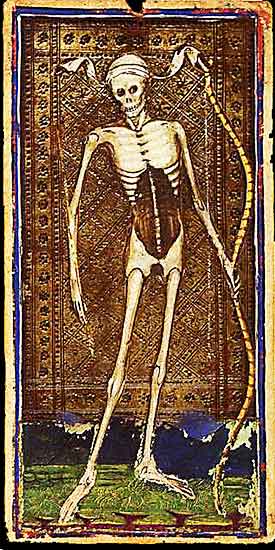 XIII – Death |
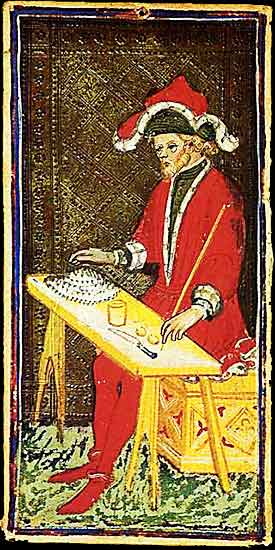 I – The Magician |
|
Emotion |
 XVIII – The Moon |
The Significator 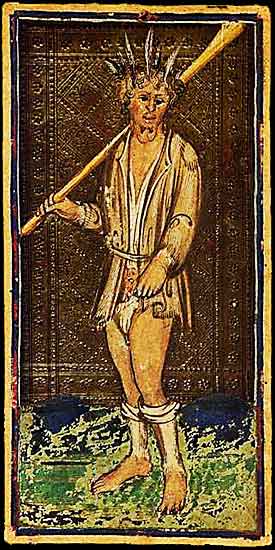 0 – The Fool |
 XIV – Temperance |
External Stance |
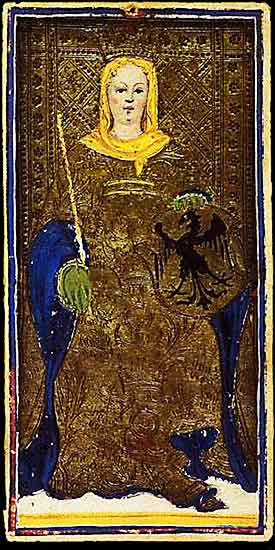 III – The Empress |
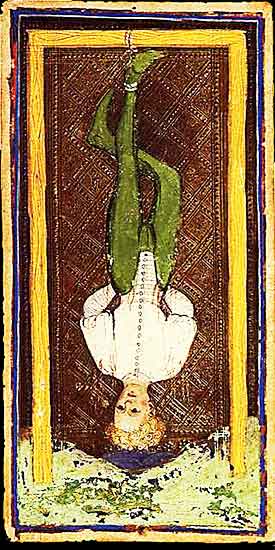 XII – The Hanged Man |

The Significator
0 – The Fool
The Fool symbolises new beginnings, innocence, and an open-hearted journey. He represents the spirit of adventure and trust in the unknown, unburdened by experiences or material concerns. His path is one of discovery, where curiosity leads the way.
Symbolism: The vagabond's tattered clothing reflects detachment from societal norms, while his staff and bundle suggest minimal baggage—both physical and emotional. The golden background highlights his eternal and universal journey. His carefree, open-mouthed expression conveys both the naivety of youth and the wisdom of freedom from expectations.
In Relationships: A signal to take risks or approach relationships with spontaneity and trust. It cautions against naivety or reckless behaviour.
In Work: An invitation to embrace a new path or project with an open mind. The Fool encourages experimentation and trust in one's instincts.
Spiritually: The Fool represents faith in the journey ahead and the courage to step into the unknown. He invites the seeker to trust the divine flow.
When ill-dignified: Foolishness, poor judgement, or recklessness. It warns against ignoring practicalities or rushing ahead blindly.

The Querent's Thoughts
XIII – Death
Death signifies the inevitable conclusion of one cycle and the heralding of another. It's a powerful symbol of transformation, renewal, and the necessity of endings to foster new beginnings.
Symbolism: The skeletal figure with a scythe represents the impartial and unrelenting nature of time and change. The image of fallen bodies suggests the end of a phase, but the subtle floral designs interwoven with the scene offer hope, symbolising rebirth and the cyclical nature of existence. The golden background emphasises the universal truth of transformation and the inevitability of all life cycles.
In Relationships: This card suggests the end of an old emotional pattern or relationship, clearing the way for renewal. Let go of what no longer serves you to make space for new, healthier connections.
In Work: Death marks the close of one professional chapter. It's a time for endings, making way for new opportunities and growth. Embrace the transition instead of fearing it.
Spiritually: Death calls for a transformation, letting go of old beliefs or attachments. Spiritual rebirth requires an embrace of the unknown and a surrender to the cycles of existence.
When ill-dignified: Resistance to change, stagnation, and fear of letting go. This can manifest as clinging to the past or an inability to move forward, hindering growth.

The Other Person's Thoughts
I – The Magician
The Magician embodies skill, potential, and the power to manifest. He represents the mastery of tools and resources, as well as the confidence to create one's reality. This card speaks of the importance of focus and action in shaping personal success.
Symbolism: The Magician's table holds simple tools, symbolising practical skills and raw materials. His Renaissance attire conveys refinement and expertise, while the golden background suggests his elevated role in shaping the material world. His seated position emphasises composure and control over his craft.
In Relationships: A call to use charm and communication to strengthen relationships. It warns of manipulation if ill-intentioned.
In Work: A time to take initiative and harness your abilities to achieve success. The Magician encourages innovation and confidence.
Spiritually: The Magician bridges the physical and spiritual, reminding the seeker to channel divine inspiration into practical actions.
When ill-dignified: Misuse of skills, deception, or scattered energy. It warns against overconfidence or manipulation.

The Querent's Emotions
XVIII – The Moon
The Moon is the card of intuition, illusion, and the subconscious. It calls attention to hidden truths, dreams, and the mysterious undercurrents that govern one's emotional landscape.
Symbolism: The barefoot woman holding a crescent moon reflects the card's connection to the primal, intuitive side of the psyche. Her gaze towards the sky suggests an awareness of the mysteries beyond the surface of reality. The wild, untamed landscape beneath her speaks to the untapped and often misunderstood forces of the unconscious mind. The golden background heightens the mystical quality, suggesting the moonlight reveals hidden paths.
In Relationships: The Moon indicates that not everything is as it seems in your romantic life. Trust your intuition, but also be cautious of illusions or deceptions.
In Work: Hidden factors or unclear circumstances may influence your professional life. The Moon calls for careful introspection and a deeper understanding of the forces at play.
Spiritually: This card calls for exploring the subconscious and trusting your intuitive wisdom. There may be deep truths that need to be uncovered.
When ill-dignified: Confusion, illusion, or deception. This warns of misunderstandings or hidden motives that could lead to emotional instability or false perceptions.

The Other Person's Emotions
XIV – Temperance
Temperance represents harmony, balance, and the art of blending opposites. It suggests a time of calm, careful moderation, and the synthesis of differing energies into a cohesive whole.
Symbolism: Pouring liquid from one vessel to another symbolises the balance and exchange between opposing forces—emotion and intellect, fire and water, inner and outer worlds. Her graceful posture and tranquil demeanour indicate deliberate action, emphasising that peace comes through moderation. The golden background elevates balance to the divine level, suggesting that harmony is sacred.
In Relationships: Temperance encourages balance in relationships. It asks for patience and moderation in interactions, fostering an environment where both partners can harmonise their differences.
In Work: Success comes through collaboration and maintaining equilibrium. This card advises you to blend your talents with those of others, seeking compromise rather than extremes.
Spiritually: Temperance represents spiritual equilibrium. It calls for integrating the material and spiritual worlds, balancing one's desires and needs for peace and alignment.
When ill-dignified: Imbalance, excess, or a lack of harmony. This could indicate dissonance in relationships, career, or spiritual practice, warning against overindulgence or extremes.

The Querent's External Stance
III – The Empress
The Empress symbolises abundance, creativity, and nurturing energy. She represents the generative force of nature and the ability to create and sustain growth, both literally and figuratively.
Symbolism: The Empress's sceptre and crown symbolise her authority, while her shield connects her to the Visconti family lineage. The floral embroidery on her gown reflects her connection to nature and fertility. The golden background underscores her divine and regal status.
In Relationships: A time of emotional abundance and nurturing. The Empress signals love, harmony, and growth.
In Work: Creative projects flourish under the Empress's guidance. She encourages nurturing ideas and building strong foundations.
Spiritually: The Empress represents the divine feminine, inviting the seeker to embrace growth and connect with nature's rhythms.
When ill-dignified: Stagnation, overindulgence, or a smothering presence in relationships.

The Other Person's External Stance
XII – The Hanged Man
The Hanged Man represents a moment of suspension, transformation, and the profound wisdom of surrender. It is the card of acceptance, urging one to release control and embrace a new perspective, even at the cost of discomfort.
Symbolism: The figure's suspended position signifies the state of hanging between worlds, a soul caught in the liminal space between the old and new. The calm expression of surrender contrasts with his precarious state, highlighting the necessity of letting go to gain understanding. The patterns of his tunic, combined with the golden glow, evoke a sacred pause in time, elevating this card to a spiritual level.
In Relationships: A time to step back and reassess your emotional life. Patience, understanding, and self-reflection are required. The card suggests moments of stillness can lead to profound growth in relationships.
In Work: Professional progress comes through rethinking old strategies. The Hanged Man indicates that a temporary pause or a shift in perspective can lead to breakthroughs.
Spiritually: The card speaks to spiritual enlightenment through sacrifice and release. You are called to surrender to the flow of life and gain higher wisdom.
When ill-dignified: Resistance to change, stagnation, and a refusal to let go. This warns against being trapped by fear or obstinance, preventing personal growth.